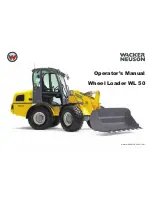
Operation Manual
60
www.xmfg.com
Operation
Load Capacity Charts
Warning
DO NOT exceed rated capacity. Any attempt
to lift or carry loads in excess of those shown
on the load capacity charts could cause tele-
handler tip over, loss of load, or structural
damage which could result in death, serious
injury, or property damage.
All load ratings shown on load capacity charts are based on
the telehandler being on firm, level ground, the forks being
evenly positioned on the carriage, the load being centered
on the forks, properly sized tires properly inflated and/or
foam filled, and the telehandler being in good operating
condition.
Using Load Capacity Charts
The reach telehandler includes two (2) indicators to assist the
operator for accurately using the load capacity charts. These
indicators are the Boom Extend Letters and the Boom Angle
Indicator.
Load capacity charts, located in the center of the dash panel
and available on the digital display, are provided to assist the
operator in determining how to safely operate the boom to
pick up, carry, and set down a load with the reach telehandler,
including what angle, how high, and how for to extend the
boom.
NOTE:
For example, when letter “A” first appears, the boom
extension corresponds to the arc of line “A” throughout all the
load capacity charts.
The boom angle indicator is located on the left side of the
boom and is visible from the operator’s seat. Use the boom
angle indicator to determine the boom angle when referring
to load capacity charts.
Fig 76. Boom Angle Indicator
Fig 74. Load Capacity Chart
Fig 75. Boom Extend Letters
NOTE:
The boom angle indicator is a plumb arrow with
angular graduations from -2.30 to +690.
Boom extend letters are located on the left side of the boom
and visible to the operator as the boom is extended. These
letters indicate boom extension as it corresponds to the load
capacity charts.















































